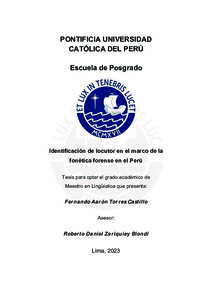| dc.contributor.advisor | Zariquiey Biondi, Roberto Daniel | |
| dc.contributor.author | Torres Castillo, Fernando Aarón | |
| dc.date.accessioned | 2023-10-31T02:24:14Z | |
| dc.date.available | 2023-10-31T02:24:14Z | |
| dc.date.created | 2023 | |
| dc.date.issued | 2023-10-30 | |
| dc.identifier.uri | http://hdl.handle.net/20.500.12404/26297 | |
| dc.description.abstract | Esta tesis describe y compara las características fonéticas de muestras indubitadas
(muestras en las que no hay dudas acerca de la identidad del locutor pues se obtienen
a partir de audiencias, declaraciones y tomas de muestra de voz) y muestras
dubitadas (muestras de las que se tiene dudas acerca de la identidad del locutor pues
se obtienen de audios de llamadas telefónicas o grabaciones donde el locutor no se
identifique). Los audios analizados pertenecen a un caso de corrupción de
funcionarios en una región del sur del Perú, y se optó por mantener a los implicados
en el anonimato, son siete (07) los efectivos policiales implicados, pero solo se
consideraron tres (03). Las muestras de voz dubitadas han sido proporcionadas por
el Ministerio Público – Fiscalía de la Nación. Dos de las muestras indubitadas se
recogieron a través de diligencias de toma de muestra de voz; y la tercera
corresponde al archivo informático de una audiencia solicitada al Poder Judicial que
corresponde a otro imputado.
En esta investigación, las muestras se organizan e interpretan en el software
SplitsTree4 con el objetivo de verificar si las voces de los locutores de las muestras
indubitadas se encuentran también en los audios de las muestras dubitadas.
Asimismo, se utiliza el programa SIS II (del paquete IKAR LAB del Speech Technology
Center) para corroborar la correspondencia de voces a partir del análisis biométrico
de voz.
En primer lugar, todos los audios fueron segmentados y anotados con rasgos
fonéticos particulares, cuya presencia y/o ausencia fue codificada de manera binaria
y sistemática para cada voz participante. Luego, esta información fue procesada por
el programa SplitsTree4 con la finalidad de reordenar los rasgos conforme a la
cantidad de voces participantes y dilucidar la coincidencia entre las voces de las
muestras intervinientes. La presente tesis obtuvo resultados positivos con respecto
del método implementado; en relación al uso de rasgos fonéticos para la identificación
forense de voz. Esto establece un aporte significativo concerniente a la aplicación de
tecnología forense a la justicia en el Perú y establece un precedente metodológico
que puede ser replicado por otros países. | es_ES |
| dc.description.abstract | This thesis describes and compare the phonetic characteristics of unquestionablespeaker
samples (samples in which there is no doubt about the identity of the speaker
as they are obtained from hearings, statements and sampled voices) and
questionable-speaker samples (samples in which there is doubt about the identity of
the speaker as they are obtained from audios of telephone calls or recordings where
the speaker does not identify him/herself). The audios analyzed belong to a case of
corruption of officials in a region of southern Peru, and it was decided to keep those
involved anonymous, and the decision was made to keep those involved anonymous,
there are seven (07) police officers implicated, but only three (03) were considered.
The questionable-speaker samples have been provided by the Public Prosecutor's
Office (Ministerio Público - Fiscalía de la Nación). Two of the unquestionable-speaker
samples were collected through voice sampling diligences, and the third sample was
obtained from the digital files of a hearing requested to the Judiciary that corresponds
to another defendant.
In this research, the samples are organized and interpreted in the SplitsTree4 software
in order to verify if the voices of the speakers of the unquestionable-speaker samples
are also found in the audios of the questionable-speaker samples. In addition, the SIS
II software (from the IKAR LAB package of the Speech Technology Center) is used to
corroborate the voice correspondence from the biometric voice analysis.
First, all the audios were segmented and annotated with particular phonetic features,
whose presence and/or absence was coded in a binary and systematic form for each
participating voice. Then, this information was processed by the SplitsTree4 software
in order to reorder the features according to the number of participating voices and to
elucidate the coincidence between the voices of the intervening samples. The present
thesis obtained positive results with respect to the implemented method; in relation to
the use of phonetic features for forensic voice identification. This establishes a
significant contribution concerning the application of forensic technology to justice in
Peru and establishes a precedent method that can be replicated by other countries. | es_ES |
| dc.language.iso | spa | es_ES |
| dc.publisher | Pontificia Universidad Católica del Perú | es_ES |
| dc.rights | info:eu-repo/semantics/openAccess | es_ES |
| dc.rights.uri | http://creativecommons.org/licenses/by/2.5/pe/ | * |
| dc.subject | Fonética forense | es_ES |
| dc.subject | Investigación criminal | es_ES |
| dc.subject | Fonética | es_ES |
| dc.subject | Lingüística | es_ES |
| dc.title | Identificación de locutor en el marco de la fonética forense en el Perú | es_ES |
| dc.type | info:eu-repo/semantics/masterThesis | es_ES |
| thesis.degree.name | Maestro en Lingüística | es_ES |
| thesis.degree.level | Maestría | es_ES |
| thesis.degree.grantor | Pontificia Universidad Católica del Perú. Escuela de Posgrado | es_ES |
| thesis.degree.discipline | Lingüística | es_ES |
| renati.advisor.dni | 40203566 | |
| renati.advisor.orcid | https://orcid.org/0000-0002-1421-1314 | es_ES |
| renati.author.dni | 71433499 | |
| renati.discipline | 232137 | es_ES |
| renati.juror | Crespo Del Rio, Claudia | es_ES |
| renati.juror | Zariquiey Biondi, Roberto Daniel | es_ES |
| renati.juror | Lazo García, Verónica Jenny | es_ES |
| renati.level | https://purl.org/pe-repo/renati/level#maestro | es_ES |
| renati.type | https://purl.org/pe-repo/renati/type#tesis | es_ES |
| dc.publisher.country | PE | es_ES |
| dc.subject.ocde | https://purl.org/pe-repo/ocde/ford#6.02.06 | es_ES |







